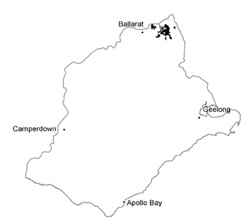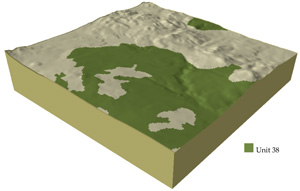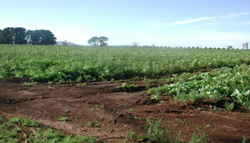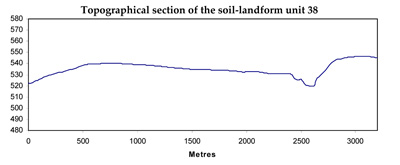Soil/Landform Unit 38
 Vast volcanic red plains of the Midlands looking towards Dunnstown from Mount Warrenheip. The soils of this area have some of the most prized in the catchment owing to their high nutrient versatility and nutrient status |
0.54% of CMA region Basaltic plains of the Midlands south of Ballarat are characterised by undulating plains and rises that support manna gum (E. viminalis), narrow-leaf peppermint (E. radiata) and messmate stringybark (E. obliqua). The Herb-rich Foothill Forests occur on the lower depressions of these plains. This unit is an intricate mixture of two land types, one with dark red gradational soils, the other having a mixture of red gradational soils on the upper slopes and a poorer grey sodic duplex soil on the lower slopes and in depressions. Agricultural land use is quite diverse and includes beef cattle and sheep grazing, water supply, horticulture (with potatoes the most common), softwood plantation and residential development. Erosion hazards are minimal. Areas with shallow stony gradational soils are susceptible to leaching of nutrients, and compaction is a problem on the lower slopes and depression. |  |
 Broad crests of red gently undulting rises support many land uses |  |
|  Horticultural crop near Millbrook |
Component | 1 | 2 | 3 |
Proportion of soil-landform unit | 34% | 33% | 33% |
| CLIMATE Rainfall (mm) | Annual: 910 | ||
| Temperature (oC) | Minimum 6, Maximum 17 | ||
| Precipitation less than potential evapotranspiration | November-March | ||
| GEOLOGY Age and lithology | |||
| Geomorphology | |||
| LANDUSE | Uncleared: Water supply; nature conservation; passive and active recreation; hardwood forestry Cleared: Beef cattle and sheet grazing; horticulture (predominantly potatoes); softwood plantations; cropping; residential development | ||
| TOPOGRAPHY Landscape | Gently undulating rises | ||
| Elevation range (m) | 495-651 | ||
| Local relief (m) | 4 | ||
| Drainage pattern | Dendritic | ||
| Drainage density (km/km2) | 1.6 | ||
| Landform | Undulating plains and rises | ||
| Landform element | Crests and upper slopes | Mid slope | Depressions |
| Slope and range (%) | 3 (1-6) | 4 (2-7) | 1 (1-2) |
| Slope shape | Convex | Straight | Concave |
| NATIVE VEGETATION Ecological Vegetation Class | Herb-rich Foothill Forest (2.5%) | ||
| Dominant species | E. viminalis, E. radiata, E. obliqua | ||
| SOIL Parent material | In situ weathered basalt | In situ weathered basalt | In situ weathered basalt |
| Description (Corangamite Soil Group) | Red gradational soil, fine structure (40) | Dark red gradational soil, fine structure (40) | |
| Soil type sites | |||
| Surface texture | Clay loam | Loam | Clay loam |
| Permeability | High | High | Moderate to low |
| Depth (m) | 2 | 1.5 | 1.5 |
| LAND CHARACTERISTICS, POTENTIAL AND LIMITATIONS | Slope exposure, leaching, overland flow, sheet erosion and nutrient decline are very minor. These soils have a high agricultural versatility. | Slope, hardsetting surfaces, leaching, overland flow, soil compaction, sheet erosion and nutrient decline are very minor. These soil shave a high agricultural versatility. | Low permeability subsoils and hardsetting surfaces combine causing waterlogging and compaction. |



